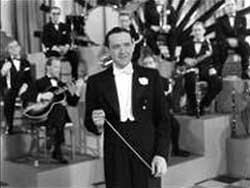 The one-reel Vitaphone musical short Jimmy Dorsey & His Orchestra (1938) was number three in the Musical Masters series.
The one-reel Vitaphone musical short Jimmy Dorsey & His Orchestra (1938) was number three in the Musical Masters series.
The film opens with a flashy fragment of Jimmy's rapid sax playing "Beebe" which he first recorded in 1929, & which became his usual show-starter.
He quickly introduces "Parade of the Milk Bottle Caps" written by himself & Charles J. McCarthy.
With musical whimsy it provides a highlight moment for nearly everyone, without Jimmy & his alto sax dominating as much as was often the case.
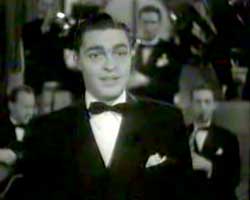 Bob Eberly takes the vocal solo for "It's the Dreamer in Me," written by Jimmy Dorsey & Jimmy Van Heusen. Bob Eberly takes the vocal solo for "It's the Dreamer in Me," written by Jimmy Dorsey & Jimmy Van Heusen.
The song became a standard, covered by everyone from Ivie Anderson with the Duke Ellington Orchestra to Martha Tilton with the Benny Goodman Orchestra.
The song begins: "When I hold you near me/ I can picture clearly/ A world of our own/ In another world we're alone/ It's the dreamer in me...."
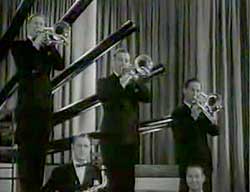 It's the sort of ballad Eberly does best, mellow & lowkey & would've been nice to dance to in its day. It's the sort of ballad Eberly does best, mellow & lowkey & would've been nice to dance to in its day.
The instrumental break is a lovely moment dominated by trumbones. A sweet number all round.
Bob's followed immediately by Evelyn Oaks singing "I Love You in Technicolor" which hardly seems complicated enough to have needed four writers, three of 'em jimmies: Nat Burton, Jimmy Van Heusen, Jimmy Dorsey, & Jimmy Shirl.
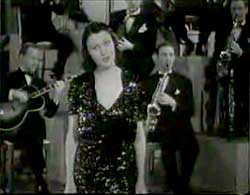 Evelyn sways from side to side in her slinky shimmering silver gown singing: Evelyn sways from side to side in her slinky shimmering silver gown singing:
"I love you in technicolor/ Think of you in technicolor/ All my dreams are color themes around you/ We strike me pink you've got me thinking of a little white house a little green lane a heaven of blue -- for two..."
It's cutesie & might've been more so if the film weren't black & white, but Evelyn's style is a bit weak for a song that really requires a more joyful lively interpretation.
The show capper was written by Jimmy Dorsey & Larry Clinton, "Dusk in Upper Sandusky."
It begins with Jimmy's alto sax, with a lively arrangement overall in which you will hear unintentional bits of "Tiger Rag." But the main point of the number is to highlight drummer Ray McKinley who gets an extended drum solo.
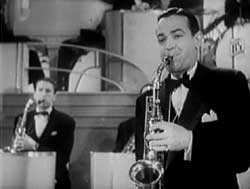 The identically titled one-reel musical short Jimmy Dorsey & His Orchestra (1940) begins with a narrator introducing Jimmy Dorsey as he signs autographs at a stage door.
The identically titled one-reel musical short Jimmy Dorsey & His Orchestra (1940) begins with a narrator introducing Jimmy Dorsey as he signs autographs at a stage door.
Jump-cut to a stage with the band performing the instrumental "Beebe" written by Dorsey & according to the narrator so difficult few musicians can play it. It begins with a sax solo by Jimmy, a fast jazzy swing tune that was indeed a standard for this orchestra, though rather a tedious piece for my tastes.
The narrator then introduces us to "girl vocalist with the Dorsey band" Helen O'Connell. We first see her on the golf course with a caddy. She can evidently hear the narrator & keeps looking over her shoulder, never getting off the golf shot.
The narrator informs us she's only nineteen, had been a professional singer since age sixteen, when she was discovered by Jimmy in a New York night club.
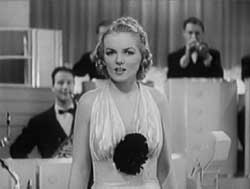 The scene fades from the golf course to the stage, where Helen's now in an evening gown about to sing "Rubber Dolly": The scene fades from the golf course to the stage, where Helen's now in an evening gown about to sing "Rubber Dolly":
"My mommy told me/ If I was goody/ That she would buy me/ A rubber dolly/ So don't you tell her/ I kissed a feller/ Or she won't buy me/ That wubber dolly/
"I know, I've been up to tricks/ Oh-oh, I'm in the fix/ I want the dolly/ Indeed I do/ But what a fella/ I want him too."
The entire orchestra stands up to do a whimsical chorus instead of the usual instrumental break, then Helen takes up new lyrics & sings with the band continuing some call & response silliness. The song becomes increasingly amusing, though musically it's fairly ordinary commercial stuff of its day.
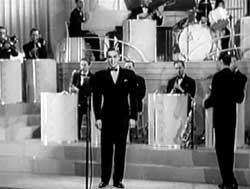 Helen's long white gown has a neckline that cuts way low in front, lower than her breasts down the middle, & it seems to have been a last-minute alteration to stick a pitch-black pompom onto the front of her gown to stop it from being quite so daring. Helen's long white gown has a neckline that cuts way low in front, lower than her breasts down the middle, & it seems to have been a last-minute alteration to stick a pitch-black pompom onto the front of her gown to stop it from being quite so daring.
In the black & white film footage this sometimes makes it look like she has a hole through her body made by a canonball.
The narrator then introduces us to the "male vocalist young Bob Eberly, discovered singing at a police benefit in his home town of Troy New York." We see him in a street scene window-shopping, then the scene fades back to the stage where he's wearing a smart dark suit & bowtie to sing "Only a Rose":
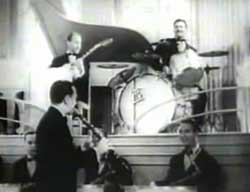 "Only a rose I give you/ Only a song dying away/ Only a smile to keep in memory/ Until we meet some other day...." "Only a rose I give you/ Only a song dying away/ Only a smile to keep in memory/ Until we meet some other day...."
The song's much too ordinary a ballad to be particularly winning, although the instrumental break with Jimmy on sax doing a duet with a floutist is appealing.
There's something cartoony about Bob's extreme broad shoulders & tiny waist that make him look a bit like Mighty Mouse. Was he a body builder or were men's suits peculiarly padded for that season of fashion?
The show closes with the Jimmy Dorsey Orchestra's best known novelty number, "John Silver," starting off with campy male chorusing by the band, & then instrumental antics written to show off the band's colorful strengths & especially Jimmy's clarnet skill. It's not quite as campy as Kay Kaiser performances but it's a little hard to embrace as serious music.
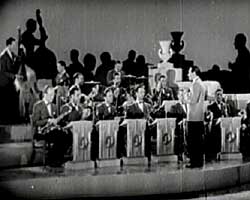 For the Panoram soundies of the 1940s, it was rare that the Mills Panoram company was able to get any of the top ten white bands to star in these three-minute films for visual jukeboxes.
For the Panoram soundies of the 1940s, it was rare that the Mills Panoram company was able to get any of the top ten white bands to star in these three-minute films for visual jukeboxes.
Several top black bandleaders, even Louis Armstrong, made soundies. But for the biggest white bandleaders, there seems to have been a sentiment that it was a step down to make these films, or perhaps it was only that they wouldn't take the pay cut.
The exception was Jimmy Dorsey, who made eight soundies in 1943. In Bar Babble (1943) Jimmy Dorsey & His Orchestra swing it to an even slap-base beat. The band does the campy group whistle, one of their trademark sounds, then Jimmy personally starts the melody on his sax.
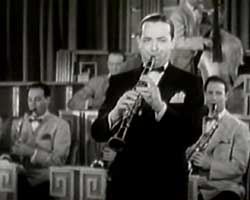 You could almost sing a jazzy version of "Shoo Fly Pie" to part of it. A trumbone solo, a bank of saxes, then a trumpet solo, it remains pretty mellow throughout, & does make you wanna wag one finger while steppin'. You could almost sing a jazzy version of "Shoo Fly Pie" to part of it. A trumbone solo, a bank of saxes, then a trumpet solo, it remains pretty mellow throughout, & does make you wanna wag one finger while steppin'.
It's filmed on the exact same set as other 1943 Dorsey soundies such as Man, that's Groovy which had Helen O'Connell doing the vocal, & the set is seen again in La Rosita (1943).
La Rosita strongly features Jimmy on clarinet then sax, with a big brass section covering him between the two instruments.
A couple other musicians get solos -- trumpeter a saxophonist -- before Jimmy takes up the clarinet anew for his close. It's a pleasant swing instrumental but a mite generic.
Despite being one of the more famous bandleaders, I wouldn't be encouraged by numbers like this to get a lot of his recordings; it's too close to elevator music. And for my personal tastes, mellow swing with some campy flourishes is no substitute for jump-jazz or ragtime.
copyright © by Paghat the Ratgirl
|
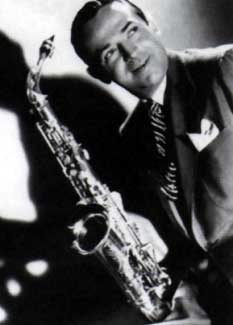

 Bob Eberly takes the vocal solo for "It's the Dreamer in Me," written by Jimmy Dorsey & Jimmy Van Heusen.
Bob Eberly takes the vocal solo for "It's the Dreamer in Me," written by Jimmy Dorsey & Jimmy Van Heusen. It's the sort of ballad Eberly does best, mellow & lowkey & would've been nice to dance to in its day.
It's the sort of ballad Eberly does best, mellow & lowkey & would've been nice to dance to in its day. Evelyn sways from side to side in her slinky shimmering silver gown singing:
Evelyn sways from side to side in her slinky shimmering silver gown singing:
 The scene fades from the golf course to the stage, where Helen's now in an evening gown about to sing "Rubber Dolly":
The scene fades from the golf course to the stage, where Helen's now in an evening gown about to sing "Rubber Dolly": Helen's long white gown has a neckline that cuts way low in front, lower than her breasts down the middle, & it seems to have been a last-minute alteration to stick a pitch-black pompom onto the front of her gown to stop it from being quite so daring.
Helen's long white gown has a neckline that cuts way low in front, lower than her breasts down the middle, & it seems to have been a last-minute alteration to stick a pitch-black pompom onto the front of her gown to stop it from being quite so daring. "Only a rose I give you/ Only a song dying away/ Only a smile to keep in memory/ Until we meet some other day...."
"Only a rose I give you/ Only a song dying away/ Only a smile to keep in memory/ Until we meet some other day...."
 You could almost sing a jazzy version of "Shoo Fly Pie" to part of it. A trumbone solo, a bank of saxes, then a trumpet solo, it remains pretty mellow throughout, & does make you wanna wag one finger while steppin'.
You could almost sing a jazzy version of "Shoo Fly Pie" to part of it. A trumbone solo, a bank of saxes, then a trumpet solo, it remains pretty mellow throughout, & does make you wanna wag one finger while steppin'.